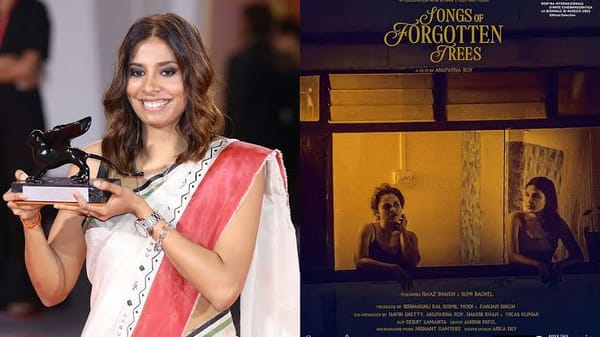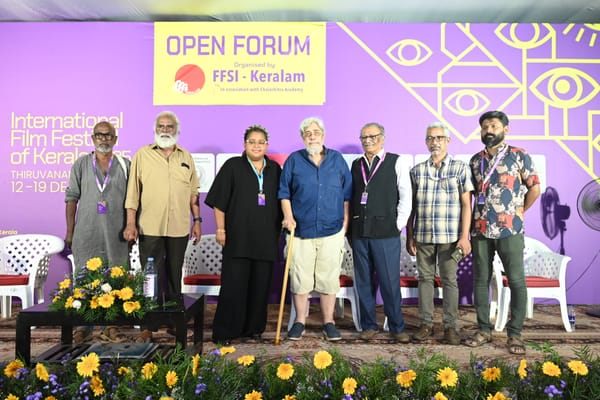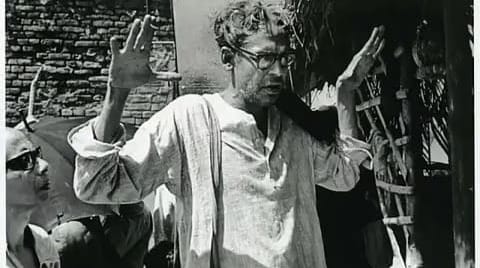Treading the path of Añjasa with Apsaras Arts
Dance productions on Buddha (the enlightened one) has always remained a favourite theme among dancers. His life story, the various incidents in his life that illumines the life of others, his self-sacrificing ways, and his principles on compassion to living beings has been tackled by dancers over th
| |
| Photo credits : Apsaras Arts ( Lijesh.K) |
Dance productions on Buddha (the enlightened one) has always remained a favourite theme among dancers. His life story, the various incidents in his life that illumines the life of others, his self-sacrificing ways, and his principles on compassion to living beings has been tackled by dancers over the years. Yet here was a dance production on Buddha which was refreshingly different. The dance production dealt on the architecture of some important Buddhist temples and weaving within it, a sketch of the life of Buddha and what he stood for.
Añjasa (pronounced Anyasa, meaning ‘the path’ in Pali) the dance production by Apsaras Arts explored the beauty of architecture journeying through eight prominent Buddhist Temples of Asia in the process unfolding Buddha’s life associated with these temples. With good choreography, appropriate costume designing, impressive lighting, appealing music and well executed by musicians and dancers the production was a treat to watch.
Their previous productions - Nirmanika and Angkor had also dealt with similar temple architecture, curious as to why select Temple architecture as themes?
Aravinth Kumarasamy, the creative director and manager of Apsaras Arts for whom temple architecture fascinates him explained...
“Temple architecture and sculpture is a subject of great interest to me as it shares many concepts and iconography with each other. My journey in conceiving and choreographing the beauty of architecture through dance started with the production Nirmanika, the research and work on this led me to be amazed by Angkor, the largest Hindu temple. Oldest built Buddhist monument of India is Sanchi, the other temple structures are a couple of centuries later, hence the interest in following the path on the research of Buddhist monuments. All the monuments that I had chosen to depict through the choreography in Nirmanika, Angkor and Añjasa are places that I have visited at least a couple of times and have spent time there, I feel that they inspire me with their beauty and legends.”
And about the research that goes into this Aravinth added…
“For Añjasa I have researched through more than 35 books on the related topics. The monuments that were selected are key pilgrimage places for Buddhist followers, some of them are connected with key incidents in the life of the Buddha like his place of birth – Lumbini -Nepal, and Buddha Gaya where he attained enlightenment, other monuments like Sanchi and Bayon are the great legacies left by rulers who propagated Buddhism. I also researched the key personalities such as King Ashoka and King Jayavarman VII and their scholarly and poetic works.”
For Mohanapriyan Thavarajah choreographer, lead dancer and dance instructor of Apsaras Arts this choice of Buddhist theme was a reminiscence. He recollected fondly his childhood in Sri Lanka, “I grew up listening to the chanting from the sacred Buddhist temple near my home on every full moon day and I have never missed attending Vesak celebration in Sri Lanka. That is the most significant occasion that remains with me and I offer my prayers to Lord Buddha. The streets, the river and buildings there would be well decorated with beautiful Vesak lanterns.”
Delving more into the some of the major elements of the dance production.
Choreographic Design has been done by Aravinth. Aravinth explains, “Choreographic Design - is to lay out a detailed vision for the imagery expected for the audience to experience and dramaturgy of the concept as it unfolds. This task also involves in setting out the specific rasas (essence /emotions) which need to be evoked and specific characterisation of the theme. This area of responsibility involves working closely with the co-choreographer on formulating dance vocabulary specific for the production. The style and dance vocab for Añjasa is very different from the other productions of Angkor or The Heroines of Raja Ravi Varma although the choreography is based on the adavu (basic steps) system of Bharathanatyam.
Based on this Mohanapriyan who has done the Choreography explains further
“To bring alive the beauty of the architecture on stage, I have chosen adavus that reflect the shape of the architecture; Bharathanatyam basic steps have structures, geometry and precise movements. The dance adavus have been conceived in such a way to depict lines, triangles, squares and circles. And to depict the characters like Mara’s daughters (demons) who try to distract Buddha’s meditation I have used Kuchipudi and Mohiniattam influences and to depict the Apsaras (celestial) dancers which are carved in Bayon temple; we used Karanas and Pada bedas (Bharathanatyam dance movements) to bring out the essence of typical Cambodian style.
The lighting design also gave us ideas to incorporate in the choreography and we even rearranged some times to make the scene more interesting.”

About costume designing:
To suit the production Mohanapriyan was careful in the choice of costume designing. “Lotus is the common iconography in Buddhism. Many Buddhist legends portray the lotus like how the Buddha walked on seven lotus flowers immediately after he was born. Buddha is seated on a lotus throne, hence I have conceived and designed the costumes and the jewellery based on the concept of lotus.”
The music in the production: Do you set the music first and set the dances to that or visualize the dances and set music to that?
Aravinth who composes music and writes the lyrics for the productions explained about the musical journey.
“Both dance and music organically evolve together. Music has to be visualized along with the choreography. The choice of Ragas, instruments, vocalisation etc are very key considerations to composing music. Being trained professionally both in dance and music it helps me to understand specific needs to make the music which inspires the dance.
Since my younger days, I drew great inspiration from Dr Padma Subhramanyam and tried to learn her approach to dance music - "Hear Dance and See Music". Both Music and Dance go hand in hand and hence they inspire each other. It is very common for me during the making process to revisit either music composition or the dance choreography to modify specific segments as its being developed.
For lyrics I either compile poetry from known poets or pen new content. For Añjasa, I penned the lyrics in Tamil.”
Añjasa covered 8 Buddhist monuments; Lumbini (Nepal), Sanchi (India), Vatadage (Sri Lanka), Bayon (Cambodia) Buddha Gaya (India), Shwedagon (Myanmar), Borobudur (Indonesia) and Wat Pho (Thailand) with dancers and musicians from Singapore, Sri Lanka, India and Malaysia.
Mohanapriyan shares what he liked most doing the production.
I loved the Chinese instruments that accompanied the orchestra of the production. Since the production covered Southeast Asian Buddhist monuments, it was nice to infuse Indian music scores with Chinese music. I really enjoyed conceiving the costumes which went hand in hand with the choreography and the moment of satisfaction came when the audience claimed that they enjoyed the visual and spiritual treat which Añjasa gave them.
What’s next on the anvil of Apsaras Arts?
Aravinth: Most of the creations take a couple of years ahead to work on them, as such while one work is on production mode the others are on their research phase. One cannot rush the work and time needed. However, ultimately the presenting a new work basically relies on securing a presenter and the required funding. Target is to create two new works every year and tour the current repertoire. Now that Añjasa has been premiered and is part of the repertoire, we are looking for opportunities to tour the work overseas.
Apsaras Arts, Dance Company was founded in Singapore in 1977 by Shri S Sathyalingam and Smt Neila Sathyalingam of Kalakshetra, India and has emerged as a premier professional performing company.
Añjasa was staged at Victoria Theatre on 23rd and 24th of January and had the support of The Singapore Buddhist Meditation Centre.





